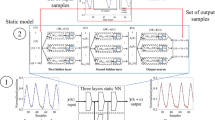Abstract
One of the possibilities to enhance the accuracy of lung radiotherapy is to improve the understanding of the individual lung motion of each patient. Indeed, using this knowledge, it becomes possible to follow the evolution of the clinical target volume defined by a set of points according to the lung breathing phase. This paper presents an innovative method to simulate the positions of points in a person’s lungs for each breathing phase. Our method, based on an artificial neural network (ANN), allowed us to learn the lung motion of five different patients and then to simulate it accurately for three other patients using only beginning and end points. The training set for our ANN consisted of more than 1,100 points spread over ten breathing phases from the five patients on a specific area of the lungs. The points were defined by a medical expert. The first results are very promising: we obtain an average accuracy of 1.5 mm while the spatial resolution is 1 × 1 × 2.5 mm3. The accuracy of the method will be improved even more with additional data and providing complete lung coverage.




Similar content being viewed by others
References
Sarrut D, Delhay B, Villard PF, Boldea V, Beuve M, Clarysse P (2007) A comparison framework for breathing motion estimation methods from 4D imaging. IEEE Trans Med Imaging 26(12):1636–1648
Villard P-F (2006) Simulation du Mouvement Pulmonaire pour un Traitement Oncologique. Thèse de doctorat en informatique no. 165-2006, Université Claude Bernard, Lyon
Boldea V, Sarrut D, Sharp G, Jiang S (2008) 4D-ct lung motion models construction with deformable registration: estimation of motion nonlinearity and hysteresis. Med Phys 35(3):1008–1018
Boldea V (2006) Intégration de la respiration en radiothérapie: apport du recalage déformable d’images. Thèse de doctorat en informatique, Université Lumière, Lyon
Hostettler A, Nicolau SA, Forest C, Soler L, Remond Y (2006) Real time simulation of organ motions induced by breathing: first evaluation on patient data. In: ISBMS, volume 4072 of LNCS, pp 9–18
Chen Y, Wang Y, Yang B (2006) Evolving hierarchical rbf neural networks for breast cancer detection. In: Neural information processing, volume 4234 of LNCS, pages 137–144
Yang Y-B, Chen S, Zhou Z-H, Lin H, Ye Y (2005) An intelligent medical image understanding method using two-tier neural network ensembles. In: IEA/AIE, pp 616–618
Alfred U, Dieter K, Kleine TO (1995) Integration of neural networks and knowledge-based systems in medicine. In: AIME, pp 425–426
Nazar E, Abdulnasir H (2009) Identification of patients with congestive heart failure using different neural networks approaches. Technol Health Care 17(4):305–312
Makovicka L, Vasseur A, Sauget M, Martin E, Gschwind R, Henriet J, Salomon M (2009) The future of new calculation concepts in dosimetry based on the monte carlo method. Radioprotection 44(1):77–88
Vasseur A, Makovicka L, Martin É, Sauget M, Contassot-Vivier S, Bahi J (2008) Dose calculations using artificial neural networks: a feasibility study for photon beams. Nucl Instrum Methods Phys Res Sect B Beam Interact Mater Atoms 266(7):1085–1093
Ramrath L, Schlaefer A, Ernst F, Dieterich S, Schweikard A (2007) Prediction of respiratory motion with a multi-frequency based extended kalman filter. In 21st international conference and exhibition, computer assisted radiology and surgery
Tchoupo G, Docef A (2008) Nonlinear set membership time series prediciton of breathing. In 16th European signal processing conference
Unkelbach J, Yi S, Schmidhuber J (2009) An em based training algorithm for recurrent neural networks. In: Artificial neural networks—ICANN, volume 5768 of LNCS, pp 964–974
Isaksson M, Jalden J, Murphy MJ (2005) On using an adaptive neural network to predict lung tumor motion during respiration for radiotherapy applications. Med Phys 32(12):3801–3809
Sahih A, Haas OCL, Goodband JH, Putra D, Mills JA, Burnham KJ (2006) Respiratory motion prediction for adaptive radiotherapy. In: IAR annual meeting
Murphy MJ, Pokhrel D (2009) Optimization of an adaptive neural network to predict breathing. Med Phys 36(1):40–47
Vandemeulebroucke J, Sarrut D, Clarysse P (2007) The popi-model, a point-validated pixel-based breathing thorax model. In: XVth international conference on the use of computers in radiation therapy (ICCR)
Hsieh WW (2009) Machine learning medthods in the environmental sciences—neural networks and kernels. Cambridge University Press, Cambridge
Nocedal J, Wright SJ (2006) Numerical optimization, 2nd edn. Springer series in operations research. Springer, New York
Sauget M, Laurent R, Henriet J, Salomon M, Gschwind R, Contassot-Vivier S, Makovicka L, Soussen C (2010) Efficient domain decomposition for a neural network learning algorithm, used for the dose evaluation in external radiotherapy. In: Diamantaras K, Duch W, Iliadis LS (eds) Artificial neural networks—ICANN 2010, volume 6352 of LNCS, Springer, pp 261–266
Seppenwoolde Y, Shirato H, Kitamura K, Shimizu S, Van Herk M, Lebesque JV, Miyasaka K (2002) Precise and real-time measurement of 3D tumor motion in lung due to breathing and heartbeat, measured during radiotherapy. Int J Radiat Oncol Biol Phys 53(4):822–834
Wu H, Langer M, Demir D, Shmukler EM, Zhao Q, Gammon N, Shirato H (2008) Hysteresis analysis of lung tumor motion in radiation treatment. Int J Radiat Oncol Biol Phys 72(1, Supplement 1):S443–S444. In: Proceedings of the American Society for Therapeutic Radiology and Oncology 50th annual meeting
Acknowledgments
The authors thank the LCC (Ligue Contre le Cancer), Région Franche-Comté, and the PMA (Pays de Montbéliard Agglomération) for their financial support. They also thank the CHUB (Centre Hospitalier Universitaire de Besançon) and, particularly, Doctors France N’Guyen, Benjamin Schipman, and Aurélien Vasseur of the Radiotherapy Service for their help on the construction of the dataset.
Author information
Authors and Affiliations
Corresponding author
Rights and permissions
About this article
Cite this article
Laurent, R., Henriet, J., Salomon, M. et al. Respiratory lung motion using an artificial neural network. Neural Comput & Applic 21, 929–934 (2012). https://doi.org/10.1007/s00521-011-0727-y
Received:
Accepted:
Published:
Issue Date:
DOI: https://doi.org/10.1007/s00521-011-0727-y




